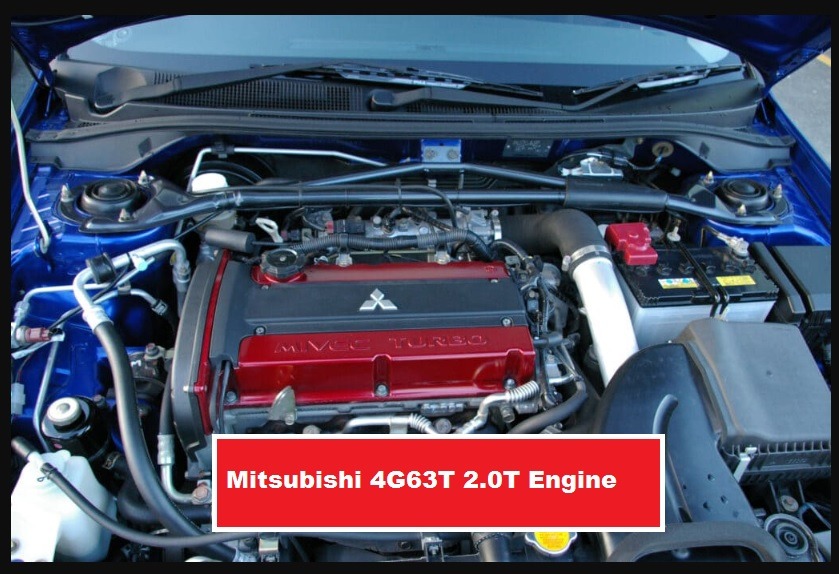Mitsubishi 4G63T 2.0T Engine Specs, Problems & Reliability
Mitsubishi 4G63T 2.0T Engine
Here in this post, I have gathered information about the Mitsubishi 4G63T 2.0T Engine from its official website, including its specifications, Problems, and Reliability.
We believe in providing reliable information to our readers, therefore we prefer to obtain information on the Mitsubishi 4G63T 2.0T Engine from authentic sources.
This article, which has been updated, has all the information you require about the Mitsubishi 4G63T 2.0T Engine.

The Mitsubishi Sirius 4G63 engine debuted alongside the rest of the 4G6 series in 1980.
The 2.0-litre gasoline, naturally aspirated, four-cylinder engine (the turbocharged version is the 4G63T engine) Developed from the G63B engine, the 4G63 features extensive upgrades (a SOHC carbureted eight-valve version was installed in different Mitsubishi models until 1986–88).
This motor has been around for quite some time, and it has seen service in many different fields (in Mitsubishi, Plymouth, Dodge, Eagle, and Hyundai vehicles).
Throughout the manufacturing process, various variants were made, each with slight modifications and new components.
| Years of release | 1981 – today |
| Engine weight | 160kg |
| Supply system | Carburetor / Injector |
| Cylinder block material | Cast iron |
| Volume | 1997 |
| Power | 109 hp at 5500 rpm |
| Number of cylinders | 4 |
| Number of valves per cylinder | 2 |
| Cylinder diameter | 85 mm |
| Piston stroke | 88 mm |
| Compression ratio | 9 |
| Torque | 159 Nm / 4500 rpm |
| Environmental standards | EURO 4 |
| Fuel | 95 |
| Fuel consumption | 13.9 l / 100 km combined |
| Oil type | 0W-40 5W-40 10W-30 10W-40 15W-40 15W-50 |
| How much oil is in the engine | 4.0 |
| When replacing the casting | 3.5 liters |
| Oil change is carried out | 10,000 km |
Mitsubishi 4G63T 2.0T Engine Problems
There could be a problem with the balancing shafts that makes them vibrate and eventually make a wedge if they aren’t greased properly when they have to carry more weight.
Worn balancing shafts must be replaced in order for the repair to be complete.
Engine mountings are another potential failure point of this power unit and should be replaced if vibrations become noticeable.
The throttle valve, the injectors, or the temperature sensor on a carbureted engine might get dusty and cause issues.
The troublesome diagnosis of a failed component adds to the complexity of the repair.
Finding the root of the problem is especially challenging with older engines that cannot undergo computerized diagnostics.
After 50,000 miles, it’s possible that your engine will have trouble starting and making a knocking sound because the hydraulic lifters have worn out.
In this instance, new hydraulic lifters will be required for repair.
To avoid costly repairs down the road, we advise using high-quality oil and getting oil changes every 10,000 kilometres.
Mitsubishi 4G63T 2.0T Engine Reliability
It is not uncommon for 4G63 engines to go beyond 250,000 miles with regular maintenance.
Further, 4G63 engines are simple to repair and rebuild due to the abundance of factory original components.
A worn balancing shaft and a clogged hydraulic filter are the most typical causes of the 4G63’s difficulties, but it is not a faultless engine by any means.
There may be a problem with the balance shaft bearings if you experience increased vibrations, choppy idling, or ticking sounds from the engine.
If the bearings on the balance shaft fail, the shaft could vibrate too much, which could cause the timing belt to break and cause expensive damage to the engine.
So, what are some good solutions to this problem? We suggest you ditch the stock balance shafts in favour of an aftermarket alternative.
While it is possible to prevent bearing failure without removing the balance shafts by using high-quality engine oil and not skipping scheduled oil change intervals, doing so is a time-consuming and inconvenient process. Even if the bearings are fine, it is still important to regularly inspect the timing belt for symptoms of wear and tear.
If your engine is experiencing rough idling, cylinder misfires, and ticking sounds, it is probable that the hydraulic lifters are to blame.
Mitsubishi 4G63T 2.0T Engine Review
Mitsubishi’s 4G63T engine was a 2.0-liter turbocharged four-cylinder engine that came out in 1989.
It was found in a wide range of Mitsubishi vehicles including Lancer Evolution, Eclipse Lancer Evolution, Eclipse, and Galant VR-4. For a full review, please check this YouTube video Here.
Mitsubishi 4G63T 2.0T Engine FAQ
How much HP can a 4G63 block handle?
With new stock-size valves, new springs, minimal port work, and a set of cams like the 414 Crowers, a 4G63 engine built for street use can handle well in excess of 500 horsepower.
(As a footnote, above 4000 rpm, the Venom sheet metal intake becomes quite useful.)
What size turbo is in 4G63?
The 4G63 Turbo has a DOHC 16-valve head with a bore and stroke of 85mm and 88mm, respectively, to produce a displacement of 2 litres.
.The static compression ratio is only 7.8:1 in the earliest turbo iteration, and the iron block is equipped with a pair of balancing shafts to dampen vibrations.
How strong is a 4G63 engine?
Induction by coercion builds. As of its most recent revision, the 4G63T engine found in the Lancer Evolution IX is capable of producing 287 horsepower and 289 pound-feet of torque.